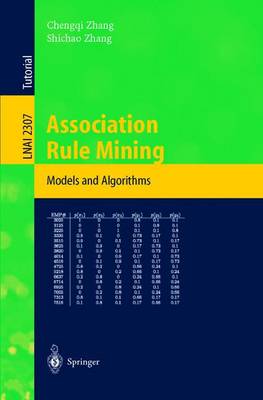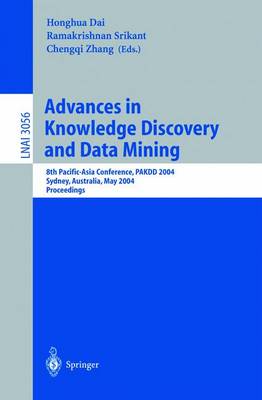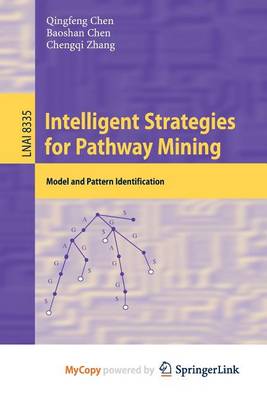Lecture Notes in Artificial Intelligence
3 primary works
Book 2307
Due to the popularity of knowledge discovery and data mining, in practice as well as among academic and corporate R&D professionals, association rule mining is receiving increasing attention.
The authors present the recent progress achieved in mining quantitative association rules, causal rules, exceptional rules, negative association rules, association rules in multi-databases, and association rules in small databases. This book is written for researchers, professionals, and students working in the fields of data mining, data analysis, machine learning, knowledge discovery in databases, and anyone who is interested in association rule mining.
The authors present the recent progress achieved in mining quantitative association rules, causal rules, exceptional rules, negative association rules, association rules in multi-databases, and association rules in small databases. This book is written for researchers, professionals, and students working in the fields of data mining, data analysis, machine learning, knowledge discovery in databases, and anyone who is interested in association rule mining.
Book 3056
Advances in Knowledge Discovery and Data Mining
by Honghua Dai, Ramakrishnan Srikant, and Chengqi Zhang
Published 11 May 2004
ThePaci?c-AsiaConferenceonKnowledgeDiscoveryandDataMining(PAKDD) has been held every year since 1997. This year, the eighth in the series (PAKDD 2004) was held at Carlton Crest Hotel, Sydney, Australia, 26-28 May 2004. PAKDD is a leading international conference in the area of data mining. It p- vides an international forum for researchers and industry practitioners to share their new ideas, original research results and practical development experiences from all KDD-related areas including data mining, data warehousing, machine learning, databases, statistics, knowledge acquisition and automatic scienti?c discovery, data visualization, causal induction, and knowledge-based systems. The selection process this year was extremely competitive. We received 238 researchpapersfrom23countries,whichisthehighestinthehistoryofPAKDD, and re?ects the recognition of and interest in this conference. Each submitted research paper was reviewed by three members of the program committee. F- lowing this independent review, there were discussions among the reviewers, and when necessary, additional reviews from other experts were requested. A total of 50 papers were selected as full papers (21%), and another 31 were selected as short papers (13%), yielding a combined acceptance rate of approximately 34%. The conference accommodated both research papers presenting original - vestigation results and industrial papers reporting real data mining applications andsystemdevelopmentexperience.Theconferencealsoincludedthreetutorials on key technologies of knowledge discovery and data mining, and one workshop focusing on speci?c new challenges and emerging issues of knowledge discovery anddatamining.ThePAKDD2004programwasfurtherenhancedwithkeynote speeches by two outstanding researchers in the area of knowledge discovery and data mining: Philip Yu, Manager of Software Tools and Techniques, IBM T.J.
Book 8335
Intelligent Strategies for Pathway Mining
by Qingfeng Chen, Baoshan Chen, and Chengqi Zhang
Published 8 January 2014
This book is organized into thirteen chapters that range over the relevant approaches and tools in data integration, modeling, analysis and knowledge discovery for signaling pathways. Having in mind that the book is also addressed for students, the contributors present the main results and techniques in an easily accessed and understood way together with many references and instances. Chapter 1 presents an introduction to signaling pathway, including motivations, background knowledge and relevant data mining techniques for pathway data analysis. Chapter 2 presents a variety of data sources and data analysis with respect to signaling pathway, including data integration and relevant data mining applications. Chapter 3 presents a framework to measure the inconsistency between heterogenous biological databases. A GO-based (genome ontology) strategy is proposed to associate different data sources. Chapter 4 presents identification of positive regulation of kinase pathways in terms of association rule mining. The results derived from this project could be used when predicting essential relationships and enable a comprehensive understanding of kinase pathway interaction. Chapter 5 presents graphical model-based methods to identify regulatory network of protein kinases. A framework using negative association rule mining is introduced in Chapter 6 to discover featured inhibitory regulation patterns and the relationships between involved regulation factors. It is necessary to not only detect the objects that exhibit a positive regulatory role in a kinase pathway but also to discover those objects that inhibit the regulation. Chapter 7 presents methods to model ncRNA secondary structure data in terms of stems, loops and marked labels, and illustrates how to find matched structure patterns for a given query. Chapter 8 shows an interval-based distance metric for computing the distance between conserved RNA secondary structures. Chapter 9 presents a framework to explore structural and functional patterns of RNA pseudoknot structure according to probability matrix. Chapter 10 presents methods to model miRNA data and identify miRNA interaction of cross-species and within-species. Chapter 11 presents an approach to measure the importance of miRNA site and the adjacent base by using information redundancy and develops a novel measure to identify strongly correlated infrequent itemsets. The discover association rules not only present important structural features in miRNAs, but also promote a comprehensive understanding of regulatory roles of miRNAs. Chapter 12 presents bioinformatics techniques for protein kinase data management and analysis, kinase pathways and drug targets, and describes their potential application in pharmaceutical industry. Chapter 13 presents a summary of the chapters and give a brief discussion to some emerging issues.


